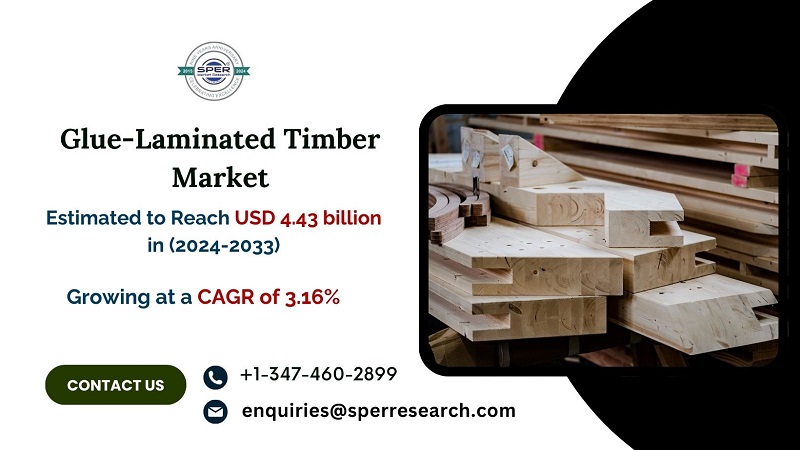Glue-laminated timber also called glulam is an engineered wood product that is made up of many parallel layers of tiny lumber pieces that are stacked and bonded together to create a huge timber structure. For mid-to high-rise building structural elements including columns, beams, and arches, it is frequently utilized. Glulam offers versatility in design by offering strength, stability, and a range of length alternatives. Like rafters and ridge beams, it provides elegance to the exposed construction segment. High load-carrying capacity, dimensional stability, and the capacity to mould the wood components into nearly any shape are characteristics of high-quality glued laminated timber. Because glued laminated wood may be found in both straight and curved shapes, there is nearly infinite design flexibility when building with wood.
According to SPER Market Research, ‘Global Glue-Laminated Timber Market Size- By Product, By Glue Type, By Lamination Configuration, By Application – Regional Outlook, Competitive Strategies and Segment Forecast to 2033’, states that the Global Glue Laminated Market is estimated to reach USD 4.43 billion by 2033 with a CAGR of 3.16%.
Drivers:
The growing emphasis on sustainability and environmental consciousness in the building sector is one of the reasons for the expansion of the worldwide glue-laminated wood business. Glulam’s eco-friendly qualities make it a desirable option for builders and architects as environmental rules and customer preferences continue to emphasize the use of green building materials. Glue-laminated wood is a popular choice in construction because of its remarkable structural qualities. Its strength-to-weight ratio is higher than that of many conventional construction materials, making it suitable for effective load carrying. The ongoing global trend of urbanization combined with population growth has led to an increased need for affordable and efficient building techniques. Glue-laminated wood is essential to satisfying these requirements.
Restraints:
Other construction materials including steel, concrete, and engineered wood products are competitors of glulam. Successfully demonstrating the market’s advantages over these alternatives is essential to its success. It is possible that certain sectors of the building sector are not fully aware of the advantages and uses of glulam. Although glulam can be a cost-effective material in many situations, it may have difficulties competing with traditional materials like steel and concrete, which have established production and supply systems. As a result, the hazards and expensive cost of glue-laminated timber may lower acceptance rates. Moisture loss can cause the component layers of glulam to shrink and fracture, compromising the material’s structural integrity and potentially resulting in structural collapse.
Request for Free Sample Report @ https://www.sperresearch.com/report-store/glue-laminated-timber-market.aspx?sample=1
The Global Glue Laminated Timber Market experienced slowdowns and project delays as a result of the COVID-19 epidemic. Construction sites experienced temporary closures or decreased capacity, which influenced the demand for glulam goods. The COVID-19 pandemic’s unexpected emergence caused numerous countries to impose strict lockdown measures, which temporarily stopped building work and reduced the market for glue-laminated lumber. The kinds of projects and applications that needed glulam changed as a result of the pandemic’s influence on consumer behaviour and tastes. The decline of COVID-19 cases and the execution of new initiatives by both public and private sectors propelled the growth of the glue laminated timber sector in the following years.
The Global Glue-laminated Timber market is dominated by Europe due to its strong construction industry and emphasis on sustainable building practices. Major players in the market are Structural Wood Systems, Inc, Mayr-Melnhof Holz Holding AG, EcoCurves BV, Forest Timber Engineering Ltd, Boise Cascade Company, and Others.
Glue-Laminated Timber Market Segmentation:
By Product Type: Based on the Product Type, Global Glue-Laminated Timber Market is segmented as; Straight Beams, Curved Beams, Arch Beams, Columns, Trusses, Others.
By Glue-Type: Based on the Glue-Type, Global Glue-Laminated Timber Market is segmented as; Phenol Formaldehyde (PF), Melamine Urea Formaldehyde (MUF), Polyurethane (PUR), Epoxy, Others.
By Lamination Configuration: Based on the Lamination-Configuration, Global Glue-Laminated Timber Market is segmented as; Horizontal Lamination, Vertical Lamination, Diagonal Lamination.
By Application: Based on the Application, Global Glue-Laminated Timber Market is segmented as; Residential Construction, Commercial Construction, Industrial Construction, Bridges and Infrastructure, Others.
By Region: This research also includes data for North America, Asia-Pacific, Latin America, Middle East & Africa, and Europe.
For More Information, refer to below link: –
Glue-Laminated Timber Market Forecast
Related Reports:
Follow Us –
LinkedIn | Instagram | Facebook | Twitter
Contact Us:
Sara Lopes, Business Consultant – USA
+1-347-460-2899


